Kynmobi
Generic name: apomorphine hydrochloride
Dosage form: sublingual film
Drug class: Dopaminergic antiparkinsonism agents
Medically reviewed by A Ras MD.
What is Kynmobi?
Kynmobi is a prescription medicine used to treat short-term (acute), intermittent “off” episodes in people with Parkinson’s disease (PD).
It is not known if Kynmobi is safe and effective in children.
Description
KYNMOBI (apomorphine hydrochloride) sublingual film contains apomorphine hydrochloride, a non-ergoline dopamine agonist. Apomorphine hydrochloride is chemically designated as 6aβ-Aporphine-10,11-diol hydrochloride hemihydrate with a molecular formula of C17H17NO2∙HCl∙½ H2O. Its structural formula and molecular weight are:
Figure 1: Structural Formula and Molecular Weight of Apomorphine Hydrochloride

The molecular weight is 312.79 (hydrochloride hemihydrate salt).
Apomorphine hydrochloride is white to grayish glistening crystals or white powder that is sparingly soluble in water and alcohol at ambient temperature.
KYNMOBI is intended for sublingual administration only and is available in 5 dosage strengths. Each film contains 10 mg, 15 mg, 20 mg, 25 mg, or 30 mg of apomorphine hydrochloride (equivalent to 8.8 mg, 13.2 mg, 17.6 mg, 22.0 mg, and 26.4 mg of apomorphine, respectively). Each film also contains the following inactive ingredients: disodium EDTA dihydrate, FD&C Blue #1, glycerol, glyceryl monostearate, hydroxyethyl cellulose, hydroxypropyl cellulose, maltodextrin, (-)-menthol, pyridoxine hydrochloride, sodium hydroxide, sodium metabisulfite, sucralose, and white ink.
Mechanism of Action
KYNMOBI is a non-ergoline dopamine agonist with high in vitro binding affinity for the dopamine D4 receptor, and moderate affinity for the dopamine D2, D3, and D5, and adrenergic α1D, α2B, α2C receptors. The precise mechanism of action of KYNMOBI as a treatment for “off” episodes associated with Parkinson’s disease is unknown, although it is believed to be due to stimulation of post-synaptic dopamine D2-type receptors within the caudate-putamen in the brain.
Who should not take Kynmobi?
Do not take Kynmobi if you are:
- taking certain medicines to treat nausea called 5HT3 antagonists including ondansetron, granisetron, dolasetron, palonosetron, and alosetron. People taking ondansetron together with apomorphine, the active ingredient in Kynmobi, have had very low blood pressure and lost consciousness or “blacked out.”
- allergic to apomorphine hydrochloride or to any of the ingredients in Kynmobi. See the end of the Patient Information guide for a complete list of ingredients in Kynmobi.
Kynmobi also contains a sulfite called sodium metabisulfite. Sulfites can cause severe, life-threatening allergic reactions in some people. An allergy to sulfites is not the same as an allergy to sulfa. People with asthma are more likely to be allergic to sulfites.
Call your healthcare provider or get emergency help right away if you get any of the following symptoms of a severe life-threatening allergic reaction:- hives
- itching
- rash
- swelling of the lips, tongue, and mouth
- redness of your face (flushing)
- throat tightness
- trouble breathing or swallowing
What should I tell my healthcare provider before taking Kynmobi?
Before you start taking Kynmobi, tell your healthcare provider about all of your medical conditions, including if you:
- have difficulty staying awake during the daytime.
- have dizziness.
- have fainting spells.
- have low blood pressure.
- have asthma.
- are allergic to any medicines containing sulfites
- have liver problems.
- have kidney problems.
- have heart problems.
- have had a stroke or other brain problems.
- have a mental problem called a major psychotic disorder.
- drink alcohol.
- are pregnant or plan to become pregnant. It is not known if Kynmobi will harm your unborn baby.
- are breastfeeding or plan to breastfeed. It is not known if Kynmobi passes into your breast milk. You and your healthcare provider should decide if you will take Kynmobi or breastfeed.
Tell your healthcare provider about all the medicines you take, including prescription medicines and, over-the-counter medicines, vitamins, and herbal supplements.
Kynmobi may affect the way other medicines work, and other medicines can affect how Kynmobi works.
Taking Kynmobi with other medicines may cause serious side effects.
- If you take nitroglycerin under your tongue (sublingual) while using Kynmobi, your blood pressure may decrease and cause dizziness. You should lie down before and after taking sublingual nitroglycerin.
Know the medicines you take. Keep a list of your medicines with you and show it to your healthcare provider and pharmacist when you get a new medicine.
How should I take Kynmobi?
- Read the step-by-step instructions for use that comes with your Kynmobi prescription.
- Take Kynmobi exactly as your healthcare provider tells you to take it.
- Your healthcare provider will tell you how much Kynmobi to take and teach you the right way to take it.
- Your healthcare provider may change your dose if needed.
- Do not change your dose of Kynmobi or take it more often than prescribed unless your healthcare provider has told you to.
- Do not take more than 1 dose of Kynmobi to treat a “OFF” episode.
- Do not take another dose of Kynmobi sooner than 2 hours after the last dose.
- Do not take Kynmobi more than 5 times a day.
- Do not cut, chew or swallow Kynmobi.
- Your healthcare provider may prescribe another medicine for nausea called an antiemetic to take while you are taking Kynmobi. Antiemetic medicines help to decrease the symptoms of nausea and vomiting that can happen when you take Kynmobi.
What should I avoid while taking Kynmobi?
- Do not drink alcohol while you are taking Kynmobi. It can increase your chance of developing serious side effects.
- Do not take medicines that make you sleepy while you are using Kynmobi.
- Do not drive, operate machinery, or do other dangerous activities until you know how Kynmobi affects you.
- Do not change your body position too fast. Get up slowly from sitting or lying. Kynmobi can lower your blood pressure and cause dizziness or fainting.
What are the possible side effects of Kynmobi?
Kynmobi can cause serious side effects, including:
- nausea and vomiting. Nausea is a common side effect of Kynmobi. Nausea and vomiting can happen with Kynmobi. Your healthcare provider may prescribe a medicine called an antiemetic, such as trimethobenzamide, to help prevent nausea and vomiting. Some patients can stop taking trimethobenzamide after using Kynmobi, when advised by your healthcare provider. Some patients may need to keep taking trimethobenzamide to help treat nausea and vomiting. Talk to your healthcare provider before you stop taking trimethobenzamide.
- sleepiness or falling asleep during the day. Sleepiness is a serious and common side effect of Kynmobi. Some people treated with Kynmobi may get sleepy during the day or fall asleep without warning while doing everyday activities such as talking, eating, or driving a car.
- allergic reactions. See “Who should not take Kynmobi?”.
- dizziness. Dizziness is a serious, and common side effect of Kynmobi. Kynmobi may lower your blood pressure and cause dizziness. Dizziness can happen when Kynmobi treatment is started or when the Kynmobi dose is increased. Do not get up too fast from sitting or after lying down, especially if you have been sitting or lying down for a long period of time.
- mouth (oral) irritation. Mouth (oral) irritation is a common side effect of Kynmobi. You should call your healthcare provider if you develop any of these signs or symptoms:
- redness
- swelling
- mouth sores (ulceration)
- pain
- dryness of the mouth, lips or tongue
- pain with swallowing
These signs and symptoms may go away if Kynmobi treatment is stopped.
- falls. The changes that can happen with PD, and the effects of some PD medicines, can increase the risk of falling. Kynmobi may also increase your risk of falling.
- hallucinations or psychotic-like behavior. Kynmobi may cause or make psychotic-like behavior worse including hallucinations (seeing or hearing things that are not real), confusion, excessive suspicion, aggressive behavior, agitation, delusional beliefs (believing things that are not real), and disorganized thinking.
- strong (intense) urges. Some people with PD have reported new or strong uncontrollable urges to gamble, increased sexual urges, increased urges to spend money (compulsive shopping), and other intense urges, while taking PD medicines, including Kynmobi. If you or your family members notice that you have strong urges, talk to your healthcare provider. The strong urges may go away if your Kynmobi dose is lowered or stopped.
- high fever and confusion. Kynmobi may cause a problem that can happen in people who suddenly lower their dose, stop using, or change their dose of Kynmobi. Symptoms include:
- very high fever
- stiff muscles
- confusion
- changes in breathing and heartbeat
Do not stop taking Kynmobi or change your dose unless you are told to do so by your healthcare provider.
- heart problems. If you have shortness of breath, fast heartbeat, chest pain, or feel like you are going to pass out (faint) while taking Kynmobi, call your healthcare provider or get emergency help right away.
- tissue changes (fibrotic complications). Some people have had changes in the tissues of their pelvis, lungs, and heart valves when taking medicines called nonergot derived dopamine agonists like Kynmobi.
- prolonged painful erections (priaprism). Kynmobi may cause prolonged, painful erections in some people. If you have a prolonged and painful erection you should call your healthcare provider or go to the nearest hospital emergency room right away.
If you have any of these symptoms, stop taking Kynmobi and call your healthcare provider right away before taking another dose.
The most common side effects of Kynmobi include:
- nausea
- sleepiness
- dizziness
- mouth swelling, pain, or sores
These are not all of the possible side effects of Kynmobi.
Call your doctor for medical advice about side effects. You may report side effects to FDA at 1-800-FDA-1088.
General information about the safe and effective use of Kynmobi
Medicines are sometimes prescribed for purposes other than those listed in a Patient Information leaflet. Do not use Kynmobi for a condition for which it was not prescribed. Do not give Kynmobi to other people, even if they have the same symptoms that you have. It may harm them. You can ask your pharmacist or healthcare provider for information about Kynmobi that is written for health professionals.
How should I store Kynmobi?
- Store Kynmobi at room temperature between 68°F to 77°F (20°C to 25°C).
- Keep Kynmobi in the foil pouch until you are ready to take it.
Keep Kynmobi and all medicines out of the reach of children.
What are the ingredients in Kynmobi?
Active ingredient: apomorphine hydrochloride
Inactive ingredients: disodium EDTA, dihydrate, FD&C Blue #1, glycerol, glyceryl monostearate, hydroxyethyl cellulose, hypromellose, maltodextrin, (-)-menthol, pyridoxine hydrochloride, sodium hydroxide, sodium metabisulfite, sucralose, and white ink.
For more information, go to www.KYNMOBI.com or call Sunovion Customer Service at 1-888-394-7377.
Instructions for use
Kynmobi (kin-moe′-bee)
(apomorphine hydrochloride)
Sublingual Film
Important
- Kynmobi is for sublingual (under your tongue) use only.
- Kynmobi must be taken whole. Do not cut, chew, or swallow Kynmobi.
- Do not take Kynmobi until you talk with your healthcare provider about how to take it.
- Check the expiration date printed on the foil pouch. Do not use Kynmobi if the expiration date has passed.
- Do not take more than 1 dose of Kynmobi every 2 hours.
- Do not take more than 5 doses of Kynmobi each day.
How to store Kynmobi
- Store Kynmobi at room temperature between 68°F to 77°F (20°C to 25°C).
- Keep Kynmobi in the foil pouch until you are ready to take it.
- Keep Kynmobi and all medicines out of the reach of children.
How Kynmobi is packaged
Inside each child-resistant carton is a plastic tray with a pull-out handle that holds the sealed pouches of Kynmobi sublingual film (see FIGURE A). Each Kynmobi sublingual film comes in a sealed foil pouch (see FIGURE B).
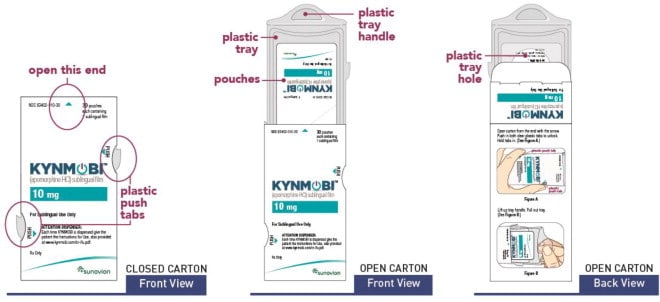
Figure A
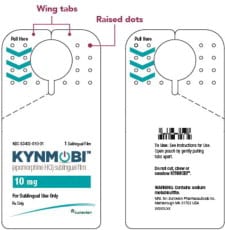
Figure B
Instructions for on How to Use the Child-Resistant Carton
| STEP 1 Open Carton | STEP 2 Remove Pouch | STEP 3 Close Carton |
| Open carton from the end with the arrow. Push in both tabs to unlock. Hold tabs in. (See FIGURE C.) Lift up tray handle. Pull out tray (see FIGURE D). |
Push finger up through the hole in the bottom of tray. (See FIGURE E.) Firmly pull one (1) pouch from the tray (see FIGURE F). |
To close, slide tray in until it clicks. (See FIGURE G.) This ensures the carton remains child resistant (see FIGURE H). |
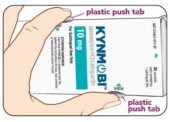 |
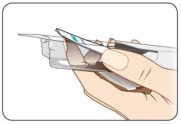 |
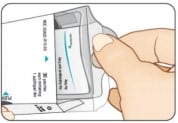 |
| Figure C | Figure E | Figure G |
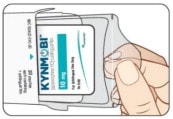 |
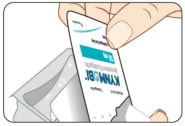 |
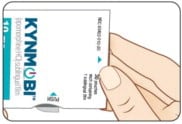 |
| Figure D | Figure F | Figure H |
Instructions for Taking Kynmobi
| Step 4 | Step 5 | Step 5 | Step 5 |
| Your healthcare provider has told you to take Kynmobi 10 mg, 15 mg, 20 mg, 25 mg, or 30 mg. Complete Steps 5 through 10 to take Kynmobi. | Drink water. Before taking each Kynmobi, drink water to moisten your mouth. This helps the film dissolve more easily (see FIGURE I). |
Open the Kynmobi foil pouch. Hold the wing tabs on the pouch between your thumb and pointer finger of each hand. Make sure to place your fingers directly on the raised dots on each wing tab. Gently pull the wing tabs apart to open the pouch (see FIGURE J). |
Take Kynmobi out of the pouch. Hold Kynmobi between your fingers by the outside edges and remove the entire Kynmobi from the pouch (see FIGURE K). Kynmobi must be taken whole. Throw away Kynmobi if it is broken or missing pieces. Use a new Kynmobi for your dose. |
 |
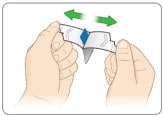 |
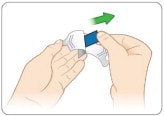 |
|
| Figure I | Figure J | Figure K |
| Step 8 | Step 9 | Step 10 |
| Place entire Kynmobi under your tongue. Place Kynmobi as far back under your tongue as you can (see FIGURE L). Close your mouth. |
Keep Kynmobi in place until it has completely dissolved (see FIGURE M).
|
Open your mouth to check if Kynmobi has completely dissolved. It can take about 3 minutes for Kynmobi to dissolve. After the film completely dissolves, you may swallow. |
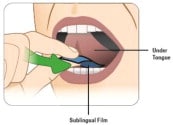 |
 |
|
| Figure L | Figure M |
For assistance with the Kynmobi child-resistant carton, please ask your care partner for help.
You may also contact your doctor or Sunovion Customer Service at 1-888-394-7377 with questions or for support.
Label
PRINCIPAL DISPLAY PANEL – TRADE POUCH LABEL – 10 mg
- NDC 63402-010-01 1 sublingual film
- KYNMOBI™
- (apomorphine HCl) sublingual film
- 10 mg
- For Sublingual Use Only
- Rx only
- SUNOVION

PRINCIPAL DISPLAY PANEL – TRADE POUCH LABEL – 15 mg
- NDC 63402-015-01 1 sublingual film
- KYNMOBI™
- (apomorphine HCl) sublingual film
- 15 mg
- For Sublingual Use Only
- Rx only
- SUNOVION

PRINCIPAL DISPLAY PANEL – TRADE POUCH LABEL – 20 mg
- NDC 63402-020-01 1 sublingual film
- KYNMOBI™
- (apomorphine HCl) sublingual film
- 20 mg
- For Sublingual Use Only
- Rx only
- SUNOVION

SRC: NLM .
